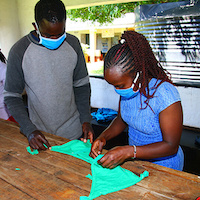From vaccinations to volleyball!
Today’s blog is by Eoin Hurley from the Harambee team now in Kenya. It’s a lively account of a day spent working with an outreach clinic. However, it’s not just entertaining. It’s a very detailed and informative report that will certainly be of interest to those of you who would like to know more about what we do during Harambee. It may be even useful for those of you considering taking part in future Harambees!
Now read on…
I’m grinning uncontrollably. I’ve spent my first day in a primary school about a 40-minute drive from base camp. Although the schoolchildren are certainly partially responsible for this jubilant mood they are not the reason for my presence at ‘Testai’. In fact it was children who wouldn’t be in school for another few years that I was dealing with.
They call it an outreach clinic, and it does exactly that. It provides essential healthcare – in this case vaccinations, progress assessments and supplements – to those who do not normally have access to any form of medicines beyond home remedies and time. The vaccinations were for polio, diphtheria and many other diseases. Progress assessments recorded weight and arm width, which were then compared to the acceptable maximum and minimum for the baby’s age. Then the nutritionist took over. Weight supplements, vitamin supplements or a combination of the two were prescribed depending on diet and weight.
But I’m getting ahead of myself. Let’s start at the start. Chai, a very sweet milky tea, drunk at least once a day by the locals, was served with breakfast. A large bowl of porridge with a chopped banana followed. Martin (CEO of Friends of Londiani) drove Carmel, a nurse from Cork University Hospital, and me out to the school. This took 40 minutes. It shouldn’t have taken that long but the rocks and mud that paved much of the way to the clinic didn’t exactly encourage high speeds.
Having collected Caroline, a member of the Friends of Londiani Kenya staff, en route, we arrived at about 9.45. We were greeted by the wide eyes, cries of ‘mzungu’ (‘white person’) and huge smiles that follow us wherever we go. The school principal, alerted to our presence by the sudden excitement, came out and welcomed us warmly. After a brief spell in his office – being welcomed even more, exchanging names and signing guest books – we were shown to the classroom-turned-clinic that would be our office for the day. The rest of the Kenyans arrived via motorbike (yes, one between three) at about 10.30 and the first mother arrived at 11 with her two-month-old fastened to her back. The baby cried upon seeing its first mzungu, but this, thankfully, wasn’t a trend.
There were scales hanging from the ceiling and the baby was left dangling in mid-air in the centre of the room as its weight was recorded. Once we had done this and checked it against age and ideal weight, the baby was passed on to Carmel and David, a nurse in a Kenyan clinic. They had a chat with the mother, offered her family planning support in the form of advice and contraceptives, and vaccinated the baby. Finally the baby was brought to the nutritionist who, as the day went on, almost invariably prescribed and supplied vitamin A tablets, and often others. This process was repeated, as babies ranging from ten days to ten months old and three to ten kg, were brought in.
During a break, Wesley, one of the health workers who had attended the school, gave me a tour. I walked into the middle of a children’s playground and was soon swamped by kids, hands outstretched. After much handshaking the class bell was rung and we continued our stroll. Wesley showed me the latrines that Friends of Londiani had constructed as part of the Healthy Schools programme. Then, as we made our way back to the clinic, the deputy informed Carmel and me that the school had been assembled to see us and thank us for the work Friends of Londiani had done.
At the assembly the head, deputy head, chairman, Caroline, Carmel and I all spoke. Then a three-year-old from the preschool class stood up and gave us a Kenyan song and dance, which was even sweeter than the chai we had had at breakfast! After seeing some classrooms – which were basic: desks and blackboards – we returned to the clinic. We saw some more mothers and babies and then had some lunch, but as the children played volleyball nearby (with a ball made from plastic bags) we were quickly converted from spectators to participants.
There was one final group of mothers and children to be checked, so an hour later we thought our day was finished. But of course the schoolchildren had different ideas and we were soon dragged into a classroom for a Q and A session before being sent off with a rendition of the Kenyan national anthem from a class that had grown from 30 to 130 in five minutes. Thankfully Martin arrived to whisk us away just as the crowd decided it was our turn for a song!
All the volunteers went into the village for a soda to celebrate the first day, and soon after dinner we retired to our rooms. I’m now in mine, writing this, looking forward to my bed and excited at the prospect of the day to come. I’ll be building smokeless stoves, but more about that next time.

